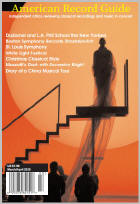Texte paru dans: / Appeared in: Audite |
|
|
Outil de traduction ~ (Très approximatif) |
|
|
Reviewer: James
Harrington These are Max Reger’s piano duet transcriptions of Bach’s 6 Branden-burg Concertos made in 1904-1905 and three other major organ works. Reger wrote “Sebastian Bach is for me the beginning and end of all music; on him rest, and from him originates, all real progress!” Countless volumes of piano duet arrangements, well into the 20th Century, seemed obligatory in the music publishing business; but Reger’s stand apart for their inventiveness and quality. He arranged many of Bach’s works in more than one version (solo piano, piano duet, 2 pianos). His many editions of Bach’s keyboard works have fallen out of favor for their excessive and very personal additions to Bach’s original texts. He said that his approach to Bach would “very much challenge the objections of pedestrian blockheads, or more politely speaking, the literal scholars lacking in imagination”. Like Reger’s very enjoyable 2-piano version of the Goldberg Variations (Schumann and Magalhaes, 2Piano 1039213, Mar/Apr 2014), I want the pianists to follow the tempos, dynamics, and phrasing that Reger was specific about in his performance instructions. He had an excellent musical mind and his ideas are well worth hearing—not to mention that the subject matter may be some of the greatest ever written. These are transcriptions in that there is not an added or deleted measure and any note changes are simply displacing a line up or down an octave or revoicing some chords to make them playable by two pianists at one keyboard. Reger wanted these to be as transparent as possible and said Fifth Concerto “was exceptionally difficult to arrange; I made countless attempts before I finally figured out the right one.”
The performances here by
Takahashi and Lehmann are amazing from every perspective. They make music in
every measure: lines are clearly delineated and shaped, they are not shy
about using the full dynamic range of the modern piano, and their virtuosity
is stunning. When I used the music and listened specifically for how Reger
divided up the notes for four hands, I was torn between Reger’s ingenuity
and the pianist’s realization of it. Audite’s recorded piano sound is state
of the art and the booklet essay is very informative. | |
|
|
|
|
Cliquez l'un ou l'autre
bouton pour découvrir bien d'autres critiques de CD |
|




